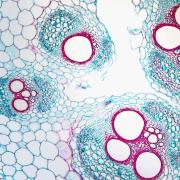Two scientists with the University of Chicago have been awarded funding by the National Institutes of Health’s High-Risk, High-Reward Research program for “visionary” scientific research.
The NIH program is intended to support exceptionally creative scientists proposing research that, due to their inherent risk, may not be otherwise funded despite their transformative potential. These projects “think beyond traditional bounds [and] pursue trailblazing ideas.”
Yamuna Krishnan, professor of chemistry, received the Pioneer Award, which entails $3.5 million of research funding over five years for an ambitious new research direction to map organelles electrochemically.
Sihong Wang, assistant professor at the University of Chicago’s Pritzker School of Molecular Engineering and researcher at Argonne National Laboratory, received the New Innovator Award for nearly $2.5 million over five years to develop biomedical implants that are more compatible with the human immune system.
Mapping cell organelles with DNA
The Pioneer Award will enable Krishnan to explore previously uncharted spaces inside cells, using an unorthodox method she pioneered: making tiny machines out of DNA.
Organelles are tiny compartments inside cells. Each type of organelle performs specific functions for the cell, just like organs of our bodies perform very specific functions for our body. Collectively, organelles work collaboratively to produce, degrade, modify and transport biomolecules around the cell, and they do so by performing specific reactions inside their lumens. To the chemist in Krishnan, organelles looked like nanoscale biochemical reactors inside the cell, and she wanted to know more about the chemical environment of the lumens of organelles. But then she found that very little was known about these inner spaces inside our cells, so curiosity drove her to build technology using DNA nanodevices to measure ions inside organelles.
She and her lab have developed techniques to mold specific nanoscale shapes of DNA. One can do this with DNA because it is essentially a thread that is only two nanometers thick, so that you can knit it into shapes on that length scale, and these shapes can be engineered to have specific functions.
With the award, she hopes to use her organellar ion-mapping technology to develop a new field of in situ organelle electrophysiology and develop an understanding of the electrical behavior of organelle membranes in neurodegenerative disease.
“My entire group is excited about this opportunity to embark on an ambitious new direction to map organelles electrochemically. I’m looking forward to exploring previously uncharted spaces inside the cell armed with this technology,” she said. “Of course, my group would not be here without the intensely stimulating environment of UChicago: It celebrates risk-taking. It nurtures a culture of learning from failure—the heart and soul of exploring the unknown.”
Biocompatible implants
Meanwhile, Sihong Wang and his team seek to develop immunocompatible electronic polymers and devices — implantable bioelectronic devices that do not trigger the body to attack the implant.
Biomedical implants have for decades been critical in treating a wide range of serious conditions, from heart attacks to diabetes. However, the majority of implants have a limited operating lifespan because of the body’s natural defenses against foreign objects, a reaction called the “foreign-body response.”
Wang’s broader work focuses on the fundamental study and development of a new class of polymeric materials and devices for future generations electronics that can be merged with human bodies and other biological systems as bioimplants or wearables.
Already, they have made breakthroughs in bio-compatible electronics, including a flexible, stretchable computing chip that processes information by mimicking the human brain.
“I am extremely honored and thrilled to receive this award,” Wang said. “It reflects the very positive concurrence from the broad biomedical community on the importance and potential impact of our research. I believe we will not only generate new fundamental understandings but also create a new class of electronic materials that will greatly improve the compatibility of implantable devices to human bodies.”
Adapted from articles by Sheila Evans at the UChicago Department of Chemistry and Andrew Nellis at the Pritzker School of Molecular Engineering.

